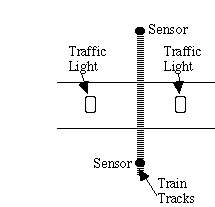
In this section of the lecture we consider a series of ethical problems which might be faced by the computer graphics professional. The intention of these exercises is to:
A. Expose you to some problems in Ethics
B. To get you to think about Professional Ethics
C. To help you develop a skill in solving Ethical problems
D. To introduce you to your professional code of Ethics
E. To help you formulate your decision making process in writing.
Your performance on the following assignment is worth 1 lab assignment on your final grade.
Your company has decided to accept a contract with the city Bridgeport to design a traffic light controller for a railroad crossing. The intersection is depicted in the figure below:

You live in Bridgeport and knew some people who died at this crossing. The railroads position is that they have a legal right of way and that all cars must yield. The traffic light has two states, red and green.
You have been running the rail road crossing gates yourself. You know that they are sometimes down when no train is coming. This, you infer, is sometimes due to a train which is parked close by.
Right away you reject the job. You say that what we really need here is an underpass. Your boss says, I know, but we are under contract and you must do a design. You are told to draw the finite-state diagram for the traffic-light controller.
What should you do?
What ethics do you consider in your design?
How does your design address these ethics?
What are the possible results of your actions?
Who shall take responsibility for these results?
After answering these questions, draw your state diagram, vouch for the safety of your device and describe how you handle device failure.
A possible response:
1. State Problem: There is something about my companies decision to take this job which makes me feel uncomfortable. People will probably continue to die at this intersection. Both the railroad and my company appear to allow the profit motive to override public safety considerations.
2. Check Facts: This is a small company, after asking my peer what they think, I am told: "Gee,%20I%20sure%20would%20not%20want%20to%20be%20in%20your%20shoes!"
3. Identify relevant factors: When people get killed or injured, you
think that they will take legal action against:
* The Rail Road (who appear
to be able to be held harmless under the law)
* Your company (whose motives
you already distrust)
* Yourself (who can hear the trouble blowing its
horn?)
3 a) What are some other factors?
According to your profession code of ethics (which you should now have) we have some clauses may which relate to the problem
3 b) What are they and why to they relate?
According to the IEEE CODE:
I.1 Members shall...Accept responsibility for their actions. "If%20someone%20dies" because of my wrong choice, it will be my fault! "
" IV.1 Members shall...Protect the safety, health and welfare of the public and speak out against abuses in those areas affecting the public interest. "If%20it" is my fault that people die then I have failed to protect them "
" According the ABET code of Ethics of Engineers, Fundamental Canons of American Society of Mechanical Engineers and the Code of Ethics of the National Society of Professional Engineers:
1. Engineers shall hold paramount the safety, health and welfare of the public in the performance of their professional duties. "If%20I%20think%20that%20people%20will" die from these actions then I have violated the most important canon "
" According to the Association of Computer Programmers and Analysts Code of Ethics
1. A computer programmer...shall accept full responsibility for this work and the consequences of computer-based systems developed by him or under his supervision. "If%20I%20accept%20the%20responsibility,%20then%20I%20have%20violated%20no%20element" of my code! "
" According to the ACM Code of Ethics:
1.2 Avoid Harm to others, where "harm" means injury or negative consequences.
The state diagram of the controller appears below:
